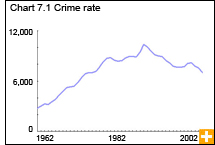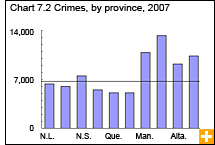Common menu bar links
Crime and justice
Archived Content
Information identified as archived is provided for reference, research or recordkeeping purposes. It is not subject to the Government of Canada Web Standards and has not been altered or updated since it was archived. Please contact us to request a format other than those available.
Based on data reported by police, Canada’s national crime rate declined for the third consecutive year in 2007, continuing the downward trend in police-reported crime since the rate peaked in 1991.
The national crime rate was 7.0 crimes per 100 people—the lowest since 1978 and 32% below its 1991 peak of 10.3 crimes per 100 people.
The drop was driven mainly by decreases in high-volume, predominantly non-violent crimes, such as counterfeiting, thefts of $5,000 and under, break-ins and motor vehicle thefts. In particular, the rate of break-ins has been steadily declining since 1991. From 2006 to 2007, the rate of residential break-ins fell 9% and break-ins to businesses dropped 8%.
Among the provinces, the highest crime rates were in Western Canada and the territories, continuing a pattern observed over the past 30 years. Despite a 4% decline, Saskatchewan continued to report the highest overall crime rate, as well as the highest rate of violent crime. British Columbia had the highest property crime rate, primarily the result of a large number of thefts of $5,000 and under. For the fourth year in a row, the lowest rates occurred in Ontario and Quebec.
Impaired driving
Impaired driving and drug offences were among the few police-reported crimes to increase in 2007 from 2006. More so than other crimes, impaired driving and drug offences tend to be influenced by local police enforcement practices.
The impaired driving rate rose 3% in 2007, mainly because of a 19% increase in Alberta. Despite this recent rise, impaired driving rates have generally been declining over the past 25 years in Canada. The rate of drug offences rose 4%, driven by an increase in cannabis possession offences, which accounted for about half of all drug offences.
About 176,000 youth aged 12 to 17 were accused of a criminal offence in 2007. Overall, youth crime has been relatively stable for the past decade, but youth violent crime has slowly increased. In 2007, young people were charged with violent crime at a rate of 8.3 crimes per 100 youths, more than double the rate reported in the mid-1980s.
Although homicides have been generally decreasing since the mid-1970s, gang-related murders are on the rise. In 2007, police reported 594 homicides. One in five—117 deaths—were reported as gang-related homicides, which includes the deaths of gang members as well as innocent bystanders.
Firearms are used more often in gang-related homicides than in other types of murder. In 2007, just over two-thirds of gang-related homicides were committed with a firearm, compared with about 20% of homicides that did not involve gangs. Within metropolitan areas, 81% of all firearm-related homicides were committed with a handgun in 2007, compared with 29% in the rest of Canada.




